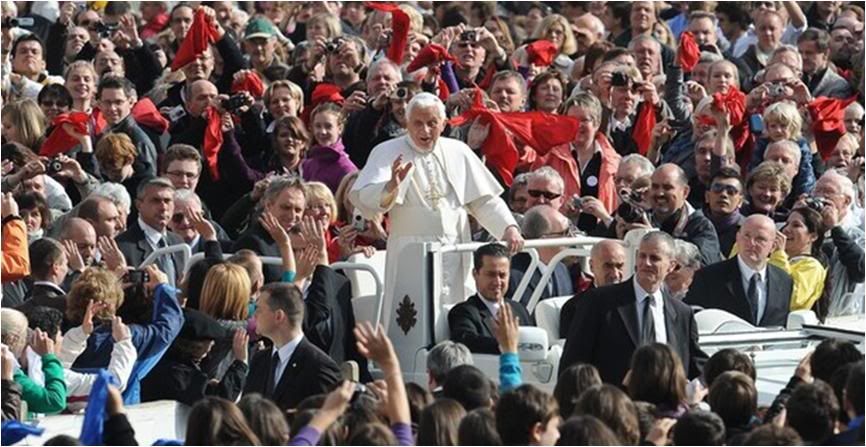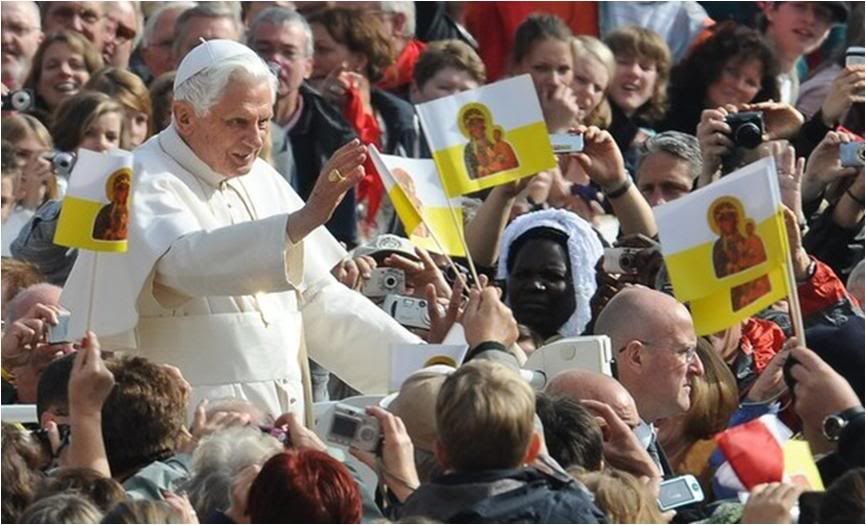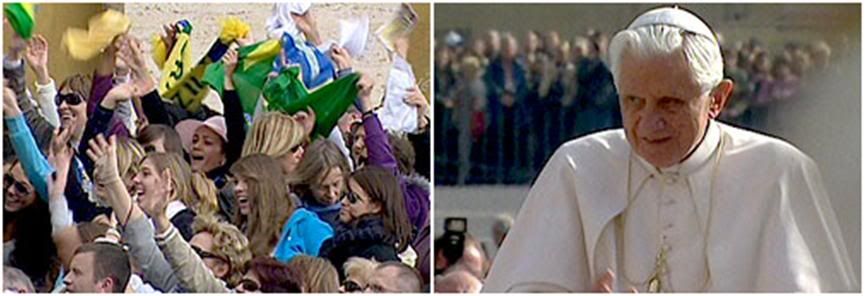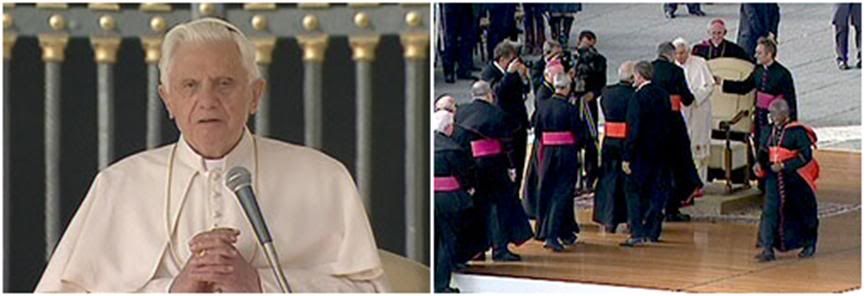| | | OFFLINE | | Post: 21.272
Post: 3.908 | Registrato il: 28/08/2005
Registrato il: 20/01/2009 | Administratore | Utente Master | |
|
 GENERAL AUDIENCE TODAY:
GENERAL AUDIENCE TODAY:
Catechesis on
St. Elizabeth of Hungary

Here is The English synthesis of the catechesis and the Pope's greeting to English-speaking pilgrims:
In our catechesis today I wish to speak about Saint Elizabeth of Hungary, also known as Saint Elizabeth of Thuringia.
She was born in the early thirteenth century. Her father was the King of Hungary, and Elizabeth was known from an early age for her fidelity to prayer and her attention to the poor.
Though she was married to Ludwig, a nobleman, for political reasons, she and her husband developed a sincere love for each other, one deepened by faith and the desire to do the Lord’s will.
In her married life, Elizabeth did not compromise her faith in spite of the requirements of life at court. She preferred to feed the poor than to dine at banquets, and to clothe the naked than to dress in costly garments.
Because of their deep faith in God, Elizabeth and Ludwig supported each other in their religious duties. After his early death, she dedicated herself to the service of the poor, always performing the humblest and most difficult works.
She founded a religious community, and lived her vows until her death at an early age. She was canonized four years later, and is a patroness of the Third Order of Saint Francis. May her dedication to the poor and needy inspire in us the same love for Christ in our neighbour.
I am pleased to welcome all the English-speaking pilgrims and visitors present today. In particular, I extend greetings to members of the Congregation of the Holy Cross and to the Sisters of Saint Joseph and the Sacred Heart, along with their students, friends and benefactors here for the canonization of Saint André Bessette and Saint Mary MacKillop. Upon all of you, I invoke God’s abundant blessings.







 Below, another one of Papino's recurring 'battles' with the wind -this time the cap falls off!
Below, another one of Papino's recurring 'battles' with the wind -this time the cap falls off!
 Here is a full translation of the Holy Father's catechesis
Here is a full translation of the Holy Father's catechesis:
Dear brothers and sisters,
Today I wish to speak of one of the women of the Middle Ages who has inspired great admiration - St. Elizabeth of Hungary, also known as Elizabeth of Thuringia.

She was born in 1207, but the historians disagree about the place. Her father was Andrew II, rich and powerful King of Hungary, who, in order to strengthen his political alliances, married the German countess Gertrude of Andechs-Meran, sister of St. Hedwig, who was the wife of the duke of Silesia.
Elizabeth lived in the Hungarian court only in the first four years of her infancy, with a sister and three brothers. She loved games, music and dance. She said her prayers faithfully and demonstrated special attention to the poor, for whom she always had a good word or an affectionate gesture.
Her happy childhood was brusquely interrupted when from far-off Thuringia, knights came to take her to her new home in central Germany. According to the custom of the time, her father had designated her princess of Thuringia. The landgrave or count of that region was one of Europe's richest and most influential sovereigns at the start of the 13th century, and his castle was a center of magnificence and culture.
But their feasts and apparent glory hid the ambitions of the principal feudal lords, often at war among themselves and in conflict with royal and imperial authorities.In this context, Landgrave Hermann gladly welcomed the engagement of his son Ludwig and the Hungarian princess.
Elizabeth left her homeland with a rich dowry and a grand entourage, including her personal handmaids, two of whom would remain her faithful friends to the very end. It is they who left us valuable information on the childhood and later life of the saint.
After a long journey, they reached Eisenach and the fortress of Wartburg, a massive castle overlooking the city. Here the engagement of Ludwig and Elizabeth was celebrated. In the years that followed, while Ludwig learned to be a knight, Elizabeth and her friends studied German, French, Latin, music, literature and embroidery.
And although the engagement had begun as a political arrangement, a sincere love developed between the two young persons, inspired by their faith and by the desire to do the will of God.
At age 18, after his father's death, Ludwig began his reign in Thuringia. But Elizabeth became the object of criticism because her ways did not correspond to life at court. Even their marriage was not a lavish feast and what would have been spent on a banquet was given to the poor instead.
Profoundly sensible, Elizabeth saw the contradictions between processed faith and Christian practice. She did not tolerate compromises. Once, entering church on the feast of the Assumption, she took off her crown, laid it in front of the Cross, and remained prostrate on the floor with her face covered.
When her mother-in-law reprimanded her for this, she answered: "How can I, a poor creature, continue to wear a crown of earthly dignity when I see my King, Jesus Christ, crowned with thorns?"
She behaved towards her subjects as she behaved towards God. Among the sayings noted down by her four handmaids, we find this testimonial: "She never ate food without first being sure that it came from her husband's property or legitimate assets. Even as she kept away from illegally acquired goods, she did all she could to make reparations to all who had undergone violence" (nn. 25 e 37).
She was a true example for all who would take on the role of leader: the exercise of authority, at every level, should be a service to justice and charity in the constant search for the common good.
Elizabeth assiduously practised works of mercy: she gave food and drink to anyone who knocked on her door. She collected clothing for them. She paid their debts. She took care of the sick and buried the dead.
Leaving the castle, she often went with her maids to the houses of the poor to bring bread, meat, flour and other basic fare. She delivered the food herself, and she carefully checked that the poor had adequate clothing and beddings.
Her behavior was reported to her husband who, not only was not displeased at all, but replied to the accusers: "As long as she does not sell the castle, I am happy".
This is the context for the famous miracle of bread that turned to roses. Once, when Elizabeth was out in the street with bread in her apron, she met her husband who who asked her what she was carrying. She opened her apron and there were roses instead of bread. This symbol of charity is often found in the depictions of St. Elizabeth. [And in quite a few other saints of whom a version of the legend has been told, like Rosa of Viterbo.]
She had a very happy marriage. Elizabeth helped her husband to elevate his human qualities to the superhuman, and in turn, he protected his wife in her generosity towards the poor and her religious practices.
Increasingly admiring the great faith of his wife, Ludwig, referring to her concern for the poor, told her: "Dear Elizabeth, it is Christ whom you have washed, fed and taken care of". A clear testimonial of how faith and love of God and one's neighbor can strengthen family life and make a matrimonial union even more profound.
The young couple found spiritual support in the Order of Friars Minor (Franciscans) who had spread throughout Thuringia since 1222. Among them, Elizabeth chose Friar Rudiger as her spiritual director. When he told her about the conversion of the young and rich Francis of Assisi, Elizabeth showed even greater enthusiasm in her chosen way of Christian living. From then on, she was even more determined to follow the crucified Christ who is present in the poor.
Even after the birth of her first son, followed by two more children, our saint never neglected her works of charity. She also helped the Friars Minor to build their convent in Halberstadt, with Friar Rudiger as abbot. Her spiritual direction passed on to Conrad of Marburg.
A hard trial for her was her husband's departure in June 1227 to join the crusade led by Emperor Frederick II. Ludwig IV reminded his wife that this had become a tradition for the sovereigns of Thuringia. She told him: "I won't hold you back. I have given all of myself to God and now, you too must do it".
But an epidemic decimated the troops, including Ludwig, who died in Otranto in 1227, at age 27, even before he could embark for the Holy Land. Learning of this, Elizabeth was so grief-stricken that she retired in solitude, but after being strengthened by prayer and comforted by the hope that they would meet again in heaven, she started to interest herself in the affairs of the kingdom.
But a new trial awaited her: her brother-in-law usurped the throne, declaring himself the true heir of Ludwig, accusing Elizabeth of being a pious woman who had no competence to govern.
The young widow and her three sons were driven out of Wartburg castle and had to look for a refuge. Only two of her maids remained with her, accompanying her and making sure that the three children were cared for by friends of Ludwig.
Wandering from village to village, Elizabeth worked wherever she was welcomed, she cared for the sick, she wove, she cooked. During this Calvary that she bore with great faith, patience and dedication to God, some relatives who remained faithful to her and considered her brother-in-law's government illegitimate, worked to rehabilitate her name.
Thus in 1228, Elizabeth was given a state income with which she could stay with her children at the family castle in Marburg, where her spiritual director Friar Conrad also came to live.
It was he who reported to Pope Gregory IX as follows: "On Good Friday of 1228, having placed her hands on the altar of the chapel in her city of Eisenach, where she had once welcomed the Friars Minor, in the presence of some friars and family members, Elizabeth renounced her own will and all the vanities of the world. She also wished to renounce all her possessions, but I dissuaded her for love of the poor. Shortly afterwards, she constructed a hospital for the invalid as well as the sick, and served the poorest and most derelict at her own table. When I counseled her on these actions, she said that she received a special grace and humility from the poor" (Epistula magistri Conradi, 14-17).
In this statement, we can see something of a mystical experience similar to that of St. Francis. The Poverello of Assisi had, in fact, declared in his spiritual will that in serving the lepers, what had once been bitter in him was transmuted into a tenderness of the soul and the body (Testamentum, 1-3).
Elizabeth spent the last three years of her life in the hospital she founded, serving the poor and keeping vigil with the dying. She always sought to carry out the most humble services and the most repugnant tasks. She became what we would call today a consecrated woman in the world (soror in saeculo) along with her friends, dressed in grey, a religious community.
Not surprisingly she became the patron saint of the Third Order of St. Francis and of the Secular Franciscan Order.
In November 1231, she was struck by a violent fever. When the news of her illness spread, many people rushed to come and see her. After ten days, she asked that the doors be closed so she could remain alone with God. And on the night of November 19, she slept sweetly in the Lord.
The testimonials on her holiness were so many and such that just four years after her death, Pope Gregory IX proclaimed her a saint, and in the same year, the beautiful church built in her honor in Marburg was consecrated.
Dear brothers and sisters, in the figure of St. Elizabeth, we see how faith and friendship with Christ create a sense of justice, of the equality of all, of rights towards others - they create love and charity. And from this charity, hope is born, the certainty that we are loved by Christ, and that the love of Christ awaits us makes us capable of imitating Christ and seeing Christ in others.
St. Elizabeth invites us to rediscover Christ, to love him, to have faith and thus find true justice and love, as well as the joy that one day, we shall be immersed in divine love, in the glory of eternity with God. Thank you.



[Modificato da TERESA BENEDETTA 21/10/2010 19:34] |